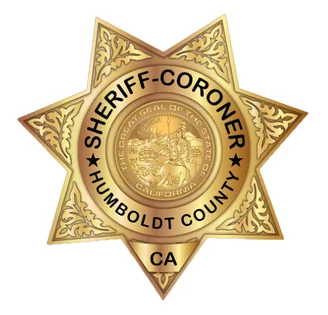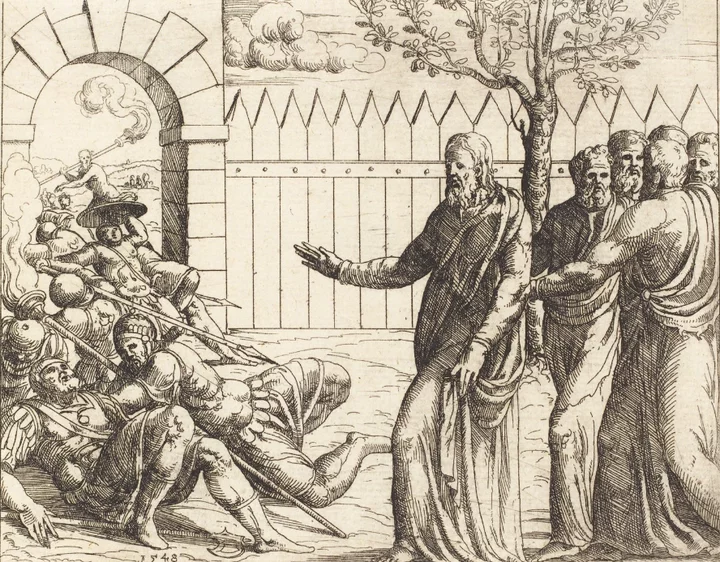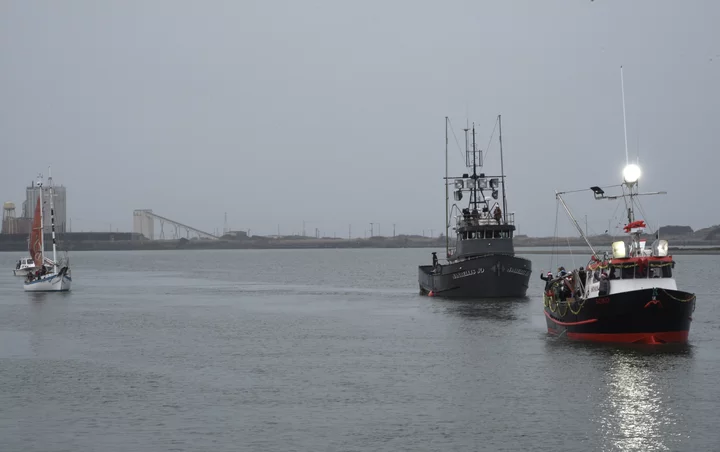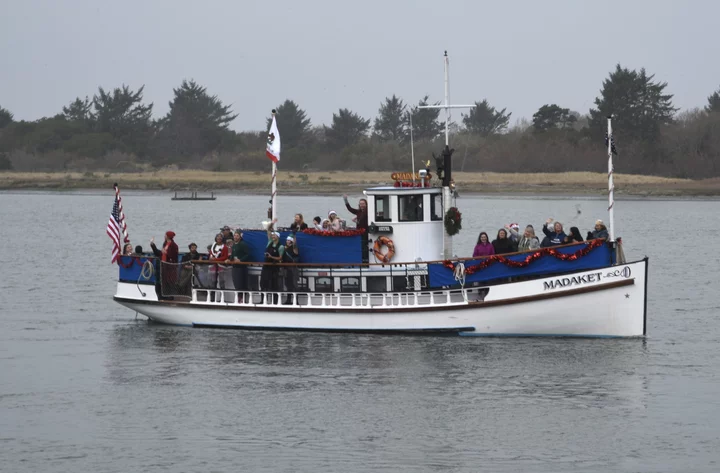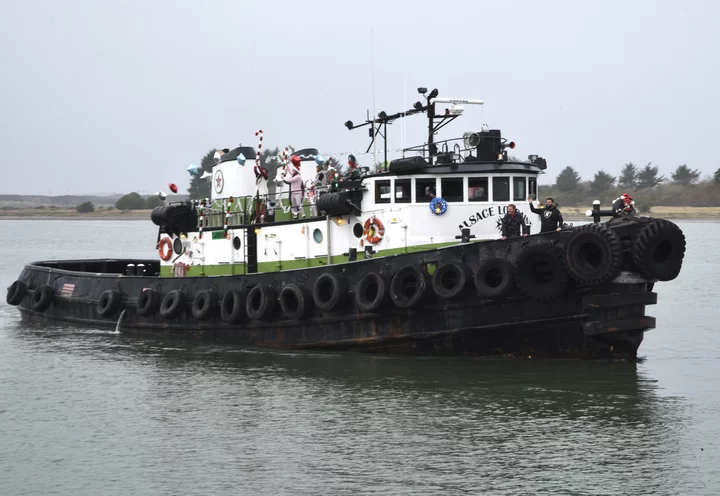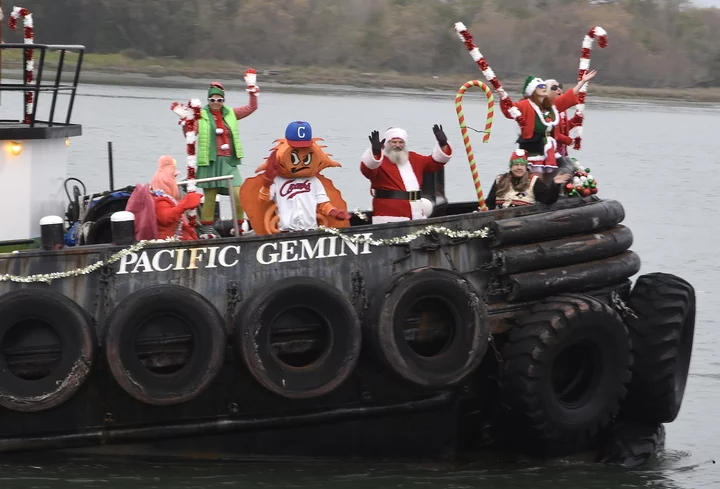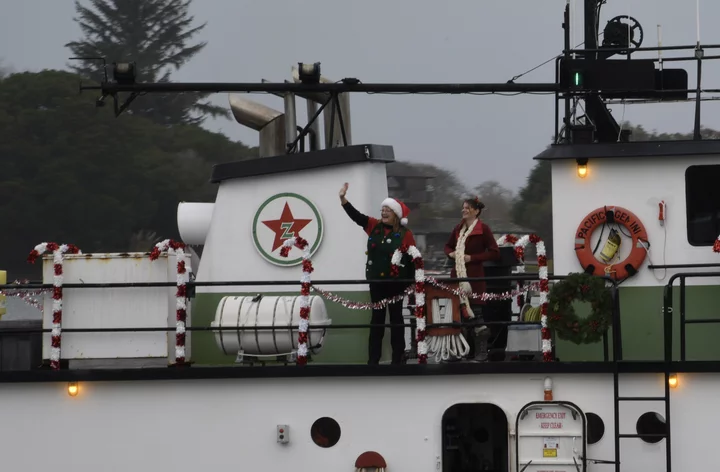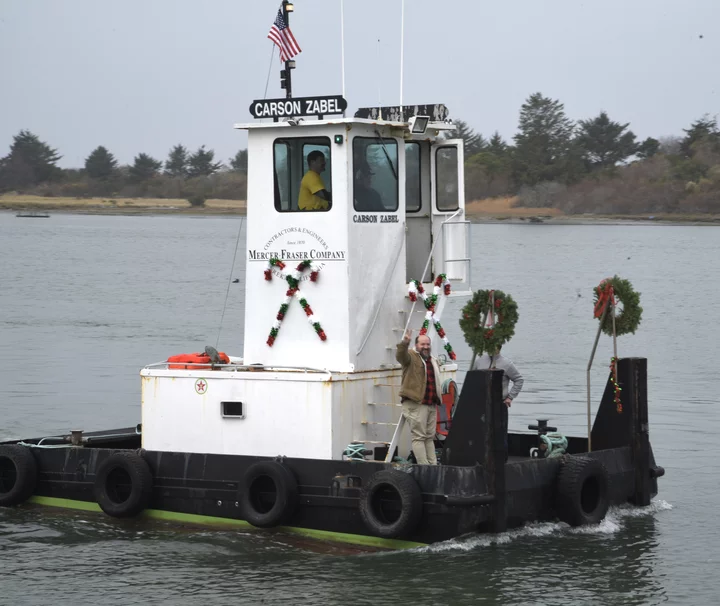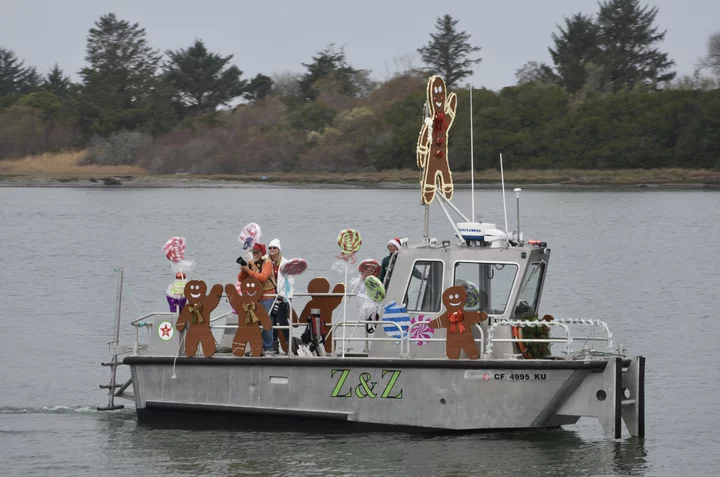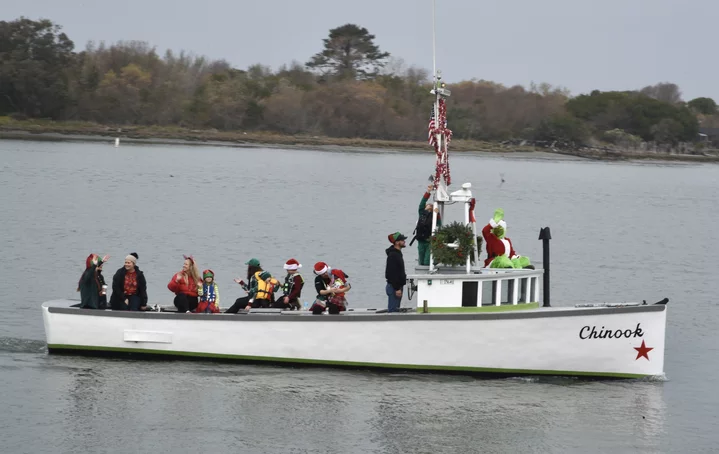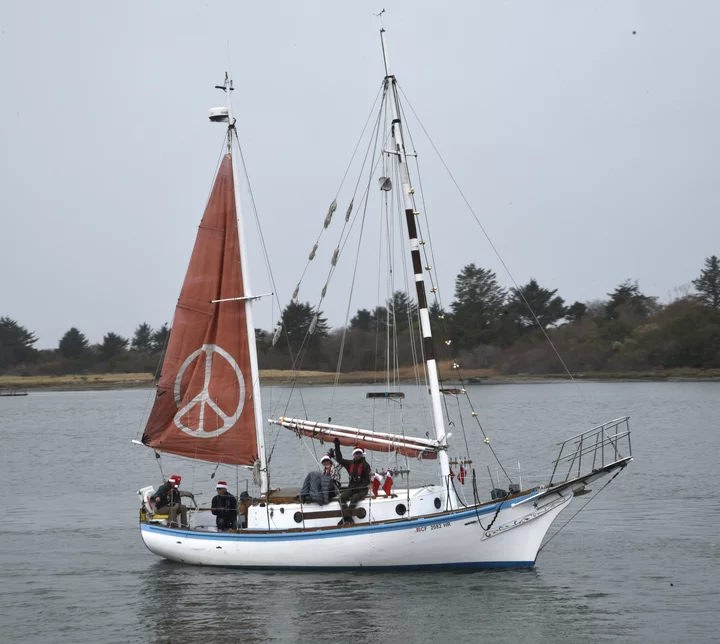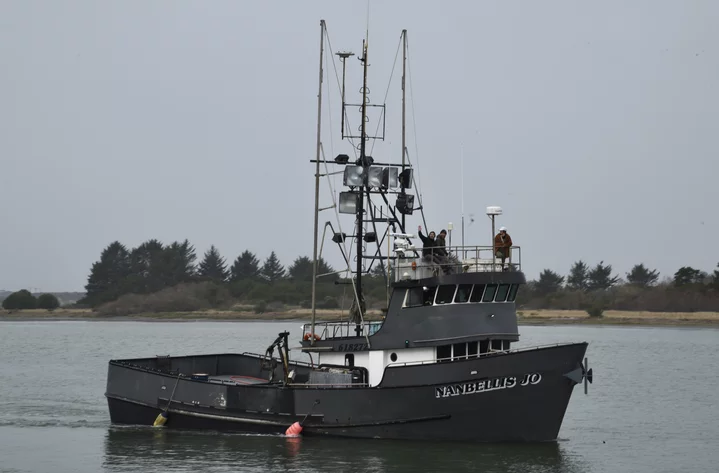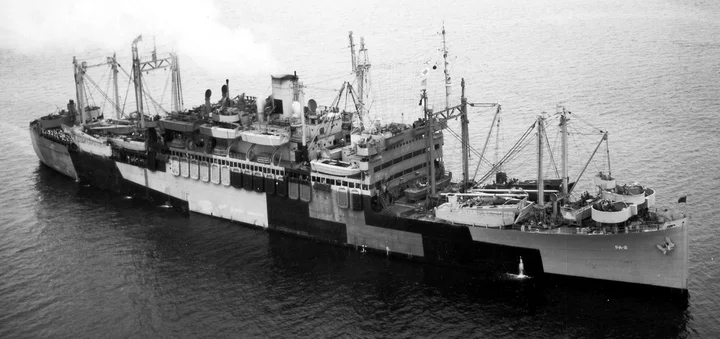Fentanyl Discovered Inside Eureka Man Following Arcata Traffic Stop
LoCO Staff / Monday, Dec. 9, 2024 @ 9:51 a.m. / Crime
Humboldt County Sheriff’s Office press release:
On Dec. 3 at about 8:30 p.m., Humboldt County Sheriff’s on patrol in the area of Highway 101 and Sunset Ave., conducted a traffic stop for a vehicle’s expired registration, CVC 4000(a).
Deputies identified the driver, Brian Adams, age 41, of Eureka, by his driver’s license and confirmed that Adams was a convicted felon for numerous drug-related charges and wanted on two misdemeanor arrest warrants.
Adams was searched incident to arrest, and deputies located pepper spray, 2.2g of methamphetamine, and a glass pipe. Adams was then taken to the Humboldt County Correctional Facility (HCCF), where 1.2g of fentanyl was located inside his rectum.
After the booking process was completed at HCCF, Adams has the following charges:
- Possession of a controlled substance—HS 11377(a)
- Possession of control substance paraphernalia—HS11364(a)
- Drug addict in possession of tear gas—PC 22810(b)
- No evidence of current registration—VC4000(a)(1)
- Bringing drugs/alcohol into penal facility—PC 4573.5
Anyone with information about this case or related criminal activity is encouraged to call the Humboldt County Sheriff’s Office at (707) 445-7251 or the Sheriff’s Office Crime Tip line at (707) 268-2539.
BOOKED
Today: 5 felonies, 11 misdemeanors, 0 infractions
JUDGED
Humboldt County Superior Court Calendar: Today
CHP REPORTS
Us101 / Indianola Cutoff (HM office): Trfc Collision-Unkn Inj
Us101 / Koa Dr (HM office): Trfc Collision-No Inj
Humboldt Loop / Upper Pacific Dr (HM office): Trfc Collision-Major Inj
3500 Mm101 N Hum 35.00 (HM office): Assist with Construction
ELSEWHERE
The Atlantic: COVID Revisionism Has Gone Too Far
The Atlantic: Laura Loomer: Making McCarthy Great Again
Washington Post: Hegseth’s expansive security requirements tax Army protective unit
Reuters: US farm agency plan to close flagship research site threatens critical research, critics warn
California Brought Back Bilingual Education. 3 Reasons Why So Few Schools Offer It
Tara García Mathewson / Monday, Dec. 9, 2024 @ 7:27 a.m. / Sacramento
Students complete assignments in Spanish together at Washington Elementary School in Madera on Oct. 29, 2024. Photos by Larry Valenzuela, CalMatters/CatchLight Local
California first demanded public education be conducted exclusively in English in 1872, a policy that stayed on the books until Ronald Reagan, as governor, signed a law to get rid of it in 1967. About a decade later, the state started to require bilingual education for kids who couldn’t understand English, taking up a Civil Rights-era argument that the children of immigrants deserved an education in their native language to be able to get the full benefits of public schooling. Other immigrant-heavy states passed the same requirements, including Texas, Illinois, and New York. But California made a radical break with its peers in 1998 when voters approved another English-only law. For nearly two decades, bilingual education became increasingly popular among native English speakers and celebrated as a best-practice for educating the children of immigrants, but the nation’s most linguistically diverse state continued to ban it.
We investigated the fallout of that ban and the state’s limping recovery since voters repealed it in 2016, conducting nearly three dozen interviews with researchers, policymakers, state education officials, advocates, bilingual educators, school leaders, teachers, parents, and students in California as well as education leaders in Texas, Illinois, and Colorado, where bilingual education has been a priority in state education policy for decades, and in Massachusetts, which is recovering from a 15-year-long ban of its own.
Three key findings:
- The Education Department is underfunded and understaffed, so its support for bilingual education hasn’t translated into widespread enrollment in these programs. Last year in California, 10% of students still learning English got a bilingual education. In Texas, 40% did — and schools got extra state money for each child enrolled in a long-term bilingual education program called dual-language immersion.
- A decades-long slump in bilingual-teacher prep programs has led to a decimated teacher pipeline, meaning there aren’t enough people to lead bilingual classrooms in K-12 schools or professors to train them. Even districts that want to start new bilingual programs haven’t been able to because they can’t find the staff.
- Unlike in the 1970s, the California Legislature has not stepped up to require bilingual education or fund a systemic recovery from the English-only years. Since Massachusetts ended an English-only law of its own, the state has awarded $11.8 million to help schools start or expand dual-language programs. California, home to 10 times the number of kids who don’t speak English, has given districts just $10 million for that work.
The Background: Why people advocate for bilingual education
Bilingual education lets kids use their native language while they learn English. Kids who already know how to read and write in one language just have to transfer those skills to a second language rather than learning the processes from scratch. Taking classes in their native language while they’re learning English also lets kids tackle more complex topics in their first language rather than having to put that off until they master English.
Dual-language programs set all students up for the “bilingual advantage.” Traditional bilingual education creates a pathway to English-only classes as quickly as possible. Succeeding in English-language classes is the goal. Increasingly popular dual-language programs, by contrast, have kids splitting the school day between two languages for their entire schooling, preparing them to reap the benefits of bilingualism in their lives and work long-term.
Dual language programs boost student outcomes. Districts with strong dual-language programs report significantly higher standardized test scores for students in those programs compared to students in general education programs. The leaps in student achievement show up by middle school. Researchers have found these programs lead to higher college entrance exam scores, high school graduation rates, and college-going rates. For kids who enter the programs not speaking English, they lead to faster English proficiency.
Dual-language programs create more integrated schools. Because dual-language programs have become so popular among English-speaking families, they represent a way to integrate classrooms with recent immigrants and those whose families came to this country generations ago.
What the Education Department has done, and what it’s up against
The state has taken steps to champion bilingual education. In 2017, the Education Department released an English Learner Roadmap, urging schools to help students who don’t speak English maintain their native languages while mastering English. In 2019, the Global California 2030 initiative named concrete goals for how soon the state’s schools should foster widespread bilingualism: By 2030, half of California students should be on a path to becoming bilingual and 1,600 schools should be running dual-language programs (more than double the number doing so in 2018).
But the state’s aspirations for bilingual education are running up against a severe teacher shortage. During the 2022-23 school year, the state commission on teacher credentialing only authorized 1,011 new bilingual teachers — across all languages. Only seven went to teachers who speak Vietnamese, the second-most-common language in California schools that year. It gave out fewer credentials to Spanish-speaking teachers that year than in the three years prior.
Patricia Gándara, a longtime bilingual education researcher and co-director of the UCLA Civil Rights Project, called the decimated teacher pipeline “one of those stories of ‘I told you so.’ … I could see what the problem was going to be: that when people came back to their senses and realized what a mistake this was, the big fallout was going to be that we didn’t have the teachers.”
Bilingual education advocates say the Legislature needs to do more.The Legislature has put $20 million toward helping districts coach up bilingual teachers and prepare them to lead bilingual classrooms and another $10 million to help districts start or expand dual-language programs. Advocates say it’s not enough.
What’s next
Statewide accountability may be coming. Gov. Gavin Newsom signed a bill this year requiring the Education Department to come up with a statewide plan for helping districts adopt the English Learner Roadmap’s guidelines and report on districts’ progress.
Supporters of bilingual education find inspiration in Texas, which never stopped requiring these programs and more recently created financial incentives for districts to start and expand dual-language programs as an even better model. Alesha Moreno-Ramirez, director of the Education Department’s Multilingual Support Division, said the Legislature would need to make the call to require bilingual education in California or create financial incentives for it.
“That said, we would enthusiastically support the movement toward requiring bilingual education,” she added.
###
CalMatters.org is a nonprofit, nonpartisan media venture explaining California policies and politics.
PASTOR BETHANY: In the Second Week of Advent, Think About the Kind of Peace You Want
LoCO Staff / Sunday, Dec. 8, 2024 @ 7 a.m. / Faith-y
The Roman Soldiers Falling Before Christ. Augustin Hirschvogel, 1547.
I settled into the local movie theater to see Gladiator II last night, surrounded by pungent stale popcorn and sweat. I’ve heard disappointment regarding this movie. Watchers were left wanting depth it never provided. It certainly lacked depth, but I found myself pondering this ancient empire that continues to fascinate, influence and compel humanity for the past 2,000+ years. Maybe Caesar is remembered today mostly as a salad dressing, but obviously that’s silly. The Caesars’ impact has reached into places and spaces they could only dream of — and dream they did. Rome fell and yet it still endures, doesn’t it?
We’re entering the second week of Advent, which traditionally comes with the word “peace.” (My intention here isn’t to convince you to believe in Jesus or go to Church. That’s not within my power. I simply desire you to think a little deeper about your own spirituality. We are spiritual beings and I believe we’re designed to connect with this part of ourselves. What God wants you to see is God’s business.)
Peace. What we all long to cultivate in our lives. That full breath. The open-handed surrender. Trust that all will be well, and all matter of things will be well. We long for peace on Earth and sing as much this time of year. We pray for peace in the Middle East while sending artillery in one hand and aid in the other — like an abuser who carefully dresses the wounds he caused
Peace. Like the Pax Romana: We’ll conquer you and kill your best and you’ll be so grateful for our rule! How did such “peace” come about? Let’s do a basic fly-over history lesson on the rise of Rome and the peace she offered.
Rome, as a republic, was perpetually at war, either in defense or to conquer. As its military might grew and the entire Italian Peninsula was taken for Rome, it defeated Carthage in 202 BCE and continued to expand and violently overthrow the known Mediterranean world. Writers of that time described the Roman Empire as having the boundaries of the Earth. Rome would make lists of the people they conquered and would erect monuments in those occupied cities.
Caesar Augustus ruled from modern-day Syria to Portugal at the time of Jesus’s birth. He was declared god incarnate on Earth, demanding prayers and sacrifices be made in his honor.
So who is Caesar Augustus? Born Octavian in 63 BCE, he was the nephew of Julius Caesar and was adopted as his son. Julius was assassinated in 44 BCE and Octavian began to rule at that point, becoming the first Emperor of Rome. Even though Rome was in continual battle with other nations and kingdoms, he made it his goal in those first years to avenge his father by creating a war at home between Caesar’s allies and those who assassinated Caesar.
Around this time, Octavian threw a party in honor of his father. During this celebration a comet was seen in the sky and Octavian said his cosmic hour had come. Witnesses came forward declaring they saw Julius ascend to the right hand of god (Zeus) making Julius a god. And if Julius was a god that would make Octavian the son of god. He inaugurated a celebration that lasted for 12 days every year and called this celebration the 12 days of advent to celebrate his birth.
In 31 BCE, Octavian defeated Marc Antony in the Battle of Actium and for the first time in 100 years Rome was not at war — there was peace throughout Rome. Octavian — renamed Augustus, meaning illustrious one, in 27 BCE — united all of Rome under himself. He took the name “Sebastos,” which means one who is worshiped or revered and inaugurated the Pax Romana. Peace through Rome. Caesar Augustus, the son of god, required all people to pay him homage by declaring “Caesar is lord.” The senate gave him the title Patar Patria, which means “Prince of Peace,” and the oracles said the kingdom of Augustus would usher in a new era of peace on Earth.
Roman priests, seen as divine mediators between people and Caesar, would alleviate past guilt through the burning of holy incense. Roman youth would create worship choruses about Caesar’s birth to be sung during advent. Caesar had coins minted with his image on them as a form of communication, showing the world who rules. If occupied by Rome, subjects were required to declare “Caesar is lord,” with threat of incarceration or violence should they rebel.
How does Rome amass such a reign? In most simplistic terms, through enormous and powerful military strength. And how would one amass this enormous military? Through paying a good wage. And how would one pay this military such a good wage? Through taxing the people. If you tax the people then you grow the military and then can grow the empire to get more people so you can keep taxing them. Depending on where people lived and how Rome was doing, the people could be taxed 80-90% of their income. These heavy taxations might demand people to sell their ancestral land — generational land passed on with deeply sacred meaning and value. Land, for the occupied Jews, promised and given by God, and now sold for tax to a hated empire.
And there was constant threat of military violence that kept these occupied peoples in line. Crucifixion was Rome’s torture of choice. The incarcerated would be beaten and tied to crosses in as many creative forms as possible until they suffered and died. They were placed in high-traffic areas so everyone would know the consequence of disrespecting Rome and Caesar.
This was Roman peace — as long as we’re not at war, we’re at peace. Peace defined by those on top. Peace for the wealthy and powerful. Peace for the few while the masses remain impoverished and the vulnerable remain afraid. And if Caesar wanted to know how big his empire was and how much money he could get from those he ruled, he would have to take a count.
Luke 2:1-5
In those days Caesar Augustus issued a decree that a census should be taken of the entire Roman world. (This was the first census that took place while Quirinius was governor of Syria.) And everyone went to their own town to register. So Joseph also went up from the town of Nazareth in Galilee to Judea, to Bethlehem the town of David, because he belonged to the house and line of David. He went there to register with Mary, who was pledged to be married to him and was expecting a child.
The Christmas story isn’t about two lovebirds who had a baby in a barn in their hometown. This is about a people displaced and occupied. And in an oppressed corner of a backwater town of ethnic minorities, a baby was born. This story rebels against unjust power structures and resists oppressive tyranny. Sixty years after enforced proclamations that Caesar is lord, people began to radically whisper “Jesus is Lord.”
Those early Christians began co-oping familiar language to transform meaning. Caesar is lord, Jesus is Lord. The good news of Caesar’s birth and his military being called “euangelion” – “good news” — and the news of Jesus’s birth, and Jesus who preached release of the captives and food for the poo,r also being called “euangelion.” Where Caesar was called the “prince of peace” through military might and violent occupation, Jesus is called the Prince of Peace through blessing and loving his enemies.
Where the kingdom of Caesar looked like the sword — oppression, pride, power, and forced worship — the way of Jesus looked like setting people free, feeding the hungry, healing the sick, advocating for the marginalized, forgiving and blessing your enemies. Jesus talked about the kingdom of God being like yeast or leaven, where a small bit can cause a whole batch to change. It started small, and looked like nothing but a band of people refusing to align with the power and pride of Rome — to align with common life together, and to care for those on the margins. It’s the smallest bit of peace, that sacred breath, a clear recognition that you are already loved and whole and you belong to God and to each other, that bit of peace which shifts hearts and moves mountains. Let there be peace on Earth and let it begin with me, the hymn goes.
So, may peace begin with you. Not through weapons and rulers or presidents and religions, but within your own body and with your own hands and words and ways of love. May peace begin with you this advent as you wait in the darkness for Light to arrive once again.
###
Bethany Cseh is a pastor at Arcata United Methodist Church and Catalyst Church.
TINY FOOTPRINTS: Holiday Gifting — It’s What’s on the Outside
Ashley Thomas / Sunday, Dec. 8, 2024 @ 7 a.m. / Tiny Footprints
Better. Photo: Pexels.
Let’s
talk about wrapping paper. It’s estimated that 4.6 million pounds
of wrapping paper are produced each year in the US. About half of
that lands in landfills. It’s hard to face the heavy juxtaposition.
On one hand, we have the bright packages glittering under the
Christmas tree, inspiring sheer delight amongst children and adults
alike for moments that are infinitely precious. On the other, we have
millions of pounds of holiday giftwrap wasting away… for centuries.
How are we to reconcile these two realities?
I’m glad you asked.
- Choose recyclable wrapping paper: I was under the impression that all wrapping paper was recyclable until more recently in life. I’ve since learned that anything glittery, metallic, or shiny is destined for the landfill. And if you crumple it up after use and it attempts to break free of its compact shape, that means it’s not recyclable either. There are some wrapping papers that are labeled as recyclable for purchase, and more power to you if you pick that up, but it’s cost prohibitive for most of us.
- Ditch the single-use mindset and re-use: Did you get your kid a massive gift for the holidays, and they (miraculously) didn’t trash the paper in the process of unwrapping? Fold that shit up! Did you receive some presents in gift bags from friends or family? If they are coated, laminated, or shiny, they’re probably not recyclable, so hold onto them. Stick them in a “bag of bags” and tuck them away until next year. Ribbons and bows? Unless the cats have destroyed them beyond recognition, there’s no reason they can’t be used again. And again. Especially the quality ones.
- Tissue paper can be reused, too: Most facilities don’t accept it for recycling, but it might be compostable. A better solution, though, is reuse. Smoothed out tissue paper is overrated. Let it be crinkly. Fold it up and use it again unless someone has shredded it in their enthusiastic glee.
- Make your own: If you have any brown paper bags lying around, you (and/or your kids) can repurpose these into a wrapping paper art project. If you have rubber stamps and ink pads, you can create an easy, repetitive design. Markers are great, too. Just a heads up that using paint, crayon, or glitter will render it unrecyclable.
- Think outside the box: There are so many alternatives to traditional gift wrapping. One LoCo commenter suggested digging up reusable totes and placing gifts inside, thus avoiding traditional wrapping paper and also getting more reusable bags in circulation. Brilliant! Do you have any dish towels, cloth napkins, fabric scraps, or scarves you have no intention of using? Wrap your gifts in that, tying it with a festive ribbon (maybe from last year). Or twine, for a rustic chic look. Gather some pine cones or use some tree trimmings to tie in. Or Crown Royal bags! Reusable giftwrap products exist, but with a little creativity it’s not necessary to buy anything, and the possibilities really open up.
- Maker’s
Apron Creative Reuse: This Old Town shop is a phenomenal gem with
countless repurposed creative goods—perfect for enveloping your
holiday gifts in. Last I checked, they had fabric for $5 a bag and
bows for cheap. And elf kits?! What more could you want? Check them
out at 317 E Street in Eureka.
- Appreciate local newspapers, in multiple ways: We have the good fortune of more than one great news source in this community! When you’re done soaking up this week’s Journal (assuming you haven’t used it as tinder to start a fire yet), wrap your gifts up in its pages! Cherry-pick the article your loved one might appreciate the most so you can discuss it together after admiring their new prized possession. Or not. Just an idea.
At the end of the day, it’s about harm reduction. Not perfection. Not piousness. If you still want a couple rolls of shiny, glittery wrapping paper, that’s an option. If you cut the amount of landfill-bound wrapping paper even by half, that’s fantastic. That’s a significant difference. It’s also about a paradigm shift. Opening up our minds to new, sustainable ways of doing things looks different. It feels different. But its final presentation can be just as intriguing, because it’s not as simple as first-glance, outward appearance. It’s the love and intention put into it.
Essentially, what’s on the inside.
###
Ashley Nichole Thomas is a marriage and family therapist who’s passionate about shrinking her carbon footprint. In her free time she writes fantasy novels, and remains unconvinced that fairies don’t exist.
OBITUARY: James Allen Hague, 1952-2024
LoCO Staff / Sunday, Dec. 8, 2024 @ 6:56 a.m. / Obits
While
surrounded by family, our amazing husband, father and grandfather,
James Allen Hague, passed away on November 25 after a courageous
battle with cancer. Jim was born February 28, 1952 in Eureka to Ira
and Viola Hague. Jim grew up in San Jose, often visiting his
grandparents in Eureka. At age 14 he started working at Baskin
Robbins, and was the manager within two years. He graduated from
Mount Pleasant High School in 1970, and immediately earned his
associates degree from Mount Diablo Community College while working
for Western Title Company. Then he attended Chico State University
for a year, before he relocated to Redcrest and enjoyed spending time
on the banks of the Eel River where he bought Monte’s Tavern. Jim
had a keen business sense that served him well in life. What a life,
fishing with friends all morning and then serving them beer all
afternoon. It was the best of both worlds! He met his future bride of
nearly 48 years, Jeannie Cooper, at his bar.
Once Jim met Jeannie, they were inseparable. In 1975, Jim’s business adventures changed from bar owner to real estate agent, and he worked for Jerry Chapman Real Estate. In 1978, they embarked on their best business venture by purchasing Western Chain Saw Company in Eureka, alongside Viola and Ira. For a few years, the family farmed corn in Shively, and Jim would come home from the shop and hop on the tractor! Jim and Jeannie ran Western Chain Saw until 2020, when their oldest son John took over the shop duties. Jim was proud of his family for operating the shop, and he was happy to have the fourth generation of Hague kids working at Western Chain Saw.
John joined the family in 1978. John’s adventuresome spirit and love for the outdoors brought much joy to the family. John worked alongside Jim for 30 years gleaning everything he could from Jim’s broad knowledge of small gas engines to the inner workings of the business.
In 1980, Matthew joined the family. Matt and Jim shared a deep love for cutting firewood together, as well as daily conversations. Jim had a nurturing relationship with each of his kids, and these daily conversations will be dearly missed.
In 1982, Anna joined the family. She added spunk and many animals to the Hague household. Word is that all she had to do was shed a tear when she brought a stray home, and Jim would say yes. Jim was proud of the strong work ethic all three children learned from their years working at the shop.
Jim and Jeannie were always together, and they spent their lives working alongside one another in all aspects of the shop, Budget Truck rental business, and in the raising of their children and any spare children, nieces and nephews that happened to be over. Their favorite place to be together was Willow Creek. Their kids were raised on the Trinity River, and he was proud of the childrens’ strong river smarts and swimming skills. Thousands of hours of family time were spent working and improving the Willow Creek property, and enjoying the weather, gardens, fishing, swimming, and best of all, family time together. The epic Fourth of July gatherings were a great example of this. Another pastime of Jim’s was cutting firewood. The family spent countless weekends in the woods filling a pickup load with the best oak and madrone they could find. Jim used to joke he measured his wealth in cords of wood!
Starting in 2006, Jim and Jeannie took on a new role that was quite possibly their favorite, Grandparenthood! Jocelyn, Robbie, Emmie and Irie followed the tradition of being raised on the banks of the Trinity River during the summers at Grandma and Grandpa’s house, and each of them inherited a keen business sense and humble understanding of kindness. Jim and Jeannie enjoyed taking trips with the kids. Grandma and Grandpa took the older and younger sets of grandkids on their own special vacations. Swimming and outdoor adventures were always the focus of these trips. In recent years, Jim spent a lot of time watching and supporting all four kids and the Anderson cousins exhibiting their livestock at both local and out of town fairs and livestock events.
In Heaven Jim joined his loving parents, Viola and Ira Hague, his in-laws Dale and Ellie Cooper, Della Williams and Eddie Barff, as well as his sister, Lael Morss. He is survived by his loving wife and best friend, Jeannie, his children, John and partner Anita, Matthew and wife Jaime, Anna and husband Stan, as well as his grandkids, Jocelyn Hague, Robbie Shoemaker, Emmie Hague, Irie Shoemaker and bonus grandchildren, Brittany, Athena, Carissa and Rogan Miller. He has many sister-in-laws and brother-in-laws, as well as nieces and nephews, cousins and friends, all of whom meant a great deal to him.
Please join us for a celebration of life on February 1, 2025 at 1 p.m. in the Great Room at the Wharfinger Building in Eureka (1 Marina Way, Eureka, CA). In lieu of flowers, please make a donation to Hospice of Humboldt at www.hospiceofhumboldt.org or a favorite charity of your choice.
As the Desiderata states, “go placidly amid the noise and haste, and remember what peace there may be in silence. As far as possible, without surrender, be on good terms with all persons. Speak your truth quietly and clearly; and listen to others.” This excerpt from the Desiderata meant a lot to Jim. He printed and framed it for each one of his kids, and he led by example. May peace be with you.
###
The obituary above was submitted on behalf of Jim Hague’s loved ones. The Lost Coast Outpost runs obituaries of Humboldt County residents at no charge. See guidelines here. Email news@lostcoastoutpost.com.
(PHOTOS/VIDEO) Salty Santa Boat Parade Returns to Old Town Eureka
Isabella Vanderheiden / Saturday, Dec. 7, 2024 @ 1:24 p.m. / Community , Feel Good
The salty Santa boat brigade attempts a honking rendition of “Jingle Bells” while tooling around Humboldt Bay. | Video/photos: Isabella Vanderheiden
###
Families crowded along the Eureka Waterfront this Saturday morning to catch a glimpse of Santa at the annual Salty Santa Boat Parade, hosted by the Commercial Fishermen’s Wives of Humboldt.
The fleet of decorated boats treated waving spectators to honking renditions of Christmas classics while cruising around Humboldt Bay, as seen in the video above. A few local celebrities appeared alongside Santa and the Grinch, including Crabby, the Humboldt Crabs Baseball mascot.
Keep scrolling for pictures of the parade!
###
HUMBOLDT HISTORY: A Eureka Sailor’s Memories of Naval Life in Honolulu, Just After the Attack on Pearl Harbor
Ted Gruhn / Saturday, Dec. 7, 2024 @ 7:30 a.m. / History
The USS Harris. Photo: U.S. Navy Bureau of Ships. Public domain.
I was 21, and I was leaving home for the first time, riding the Northwestern Pacific Railroad from
Humboldt County to the Naval Training Center in San Diego; from there, I was to ship out to Pearl
Harbor on December 4, 1941.
###
September 20, 1941: Pop woke me. He wanted to say goodbye before his ride to work arrived. I hadn’t slept much; I was too keyed up. Two weeks earlier, I had enlisted in the Naval Reserve as a carpenter’s mate, third class. I qualified for that rate because I had completed an apprenticeship in the Carpenter’s Union: that meant only three weeks in boot camp, and a starting pay of $60 a month, instead of the $21 a month as an apprentice seaman. The enlistment was for one year. Mom was up. as was my younger brother. Frank, and my sisters, Helen, and Marion. My older brother, Al, drove me to the station. I left with a change of clothes and my Ziess camera. Two and a half years and 200,000 miles of water passed under my feet before I saw my family again.
Mom had packed a lunch for me to eat on the train; there was no dining car on the Northwestern Pacific between Eureka and San Rafael. At the depot, I bought a couple of Cokes. Walter Cave, the conductor and a neighbor of ours, greeted me. There were very few people in the three passenger cars that foggy morning.
I had ridden a train once — a logging train, when I was twelve. Howard Smeds and Varvel Carter and I had hitched a ride to the logging camp southeast of the Cutten Tract where Howard’s aunt worked as a waitress in the cookhouse. We were angling for a free lunch.
We rode our bikes as far as we could up the trail, stashed them, and walked to the clearing that met the railroad where it made a sharp bend on an uphill grade. The train had to slow down at that point and it was easy to catch one of the empty cars.
Howard’s aunt gave us a good lunch. When the train was loaded with logs, we hitched a ride back to our bikes.
Several years later, we made the trip again, only this time, it was a long hike. In the Depression years, the mill had gone into receivership, and the logging camp was abandoned. The rails and cross-ties were removed. The six or seven trestles, some fifty to seventy feet high, were left with two large girders supporting the cross ties and the rails. Without railings, we walked those girders on the trestles high above the stream. Vandals had broken the windows in the camp, but the stove, tables, and benches remained in the cookhouse. Cots and mattresses, torn and littered by pack rats, were the bunkhouse.
December 6, 1941: Aboard the USS Harris, at sea. The weather was better: we’d had a windy night. Topside, the rail was lined with sailors hanging their heads over the rail; to get to the chow line, we had to step over seasick sailors lying on the deck.
My best friend from boot camp. Morry Couch, and I were up on the deck near the fantail, relaxing on a metal still in ready box. I said, “Morry, I’ll be twenty-two tomorrow. Do you think Cookie will bake me a chocolate cake?”
“It’s Sunday,” Morry said. “We’ll probably have cake for dessert.”
December 7, 1941: Morry and I were standing on the deck at 0730. We’d eaten breakfast, and we were watching the sun rise over the white caps ofthe Pacific.
“Happy birthday, Ted,” Morry said. “I bet you’ll never forget this one.”
Suddenly, the PA system crackled and the captain spoke. “… Pearl Harbor has been attacked by the Japanese Air Force…. We are now at war with the Empire of Japan…”
Only a year earlier, a Japanese ship had pulled into Humboldt Bay and taken on a load of scrap iron. Now, I thought, they’re going to shoot it back at me.
December 11, 1941: The USS Harris entered the channel to Pearl Harbor. We lined the rail on both sides, and approached a battleship on the port side. She was hard aground, her hull low in the water. It was the USS Nevada. The USS California was next. Her #l 14-inch gun turret was awash with water lapping at the barrels.
We saw the Oklahoma with half its bottom and keep showing; the West Virginia and Tennessee were burned-out hulks, sitting low in the water. Only the top of the 14- inch #2 gun turret on the Arizona was visible.
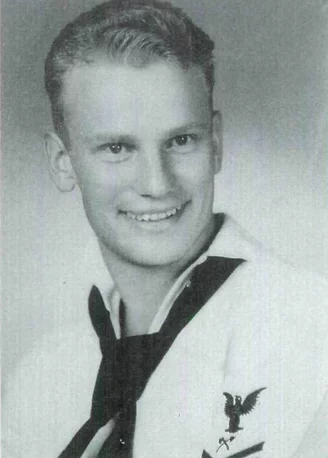
Ted Gruhn, following boot camp in 1941, a carpenter’s male, third class. Photo courtesy of the author. via the Humboldt Historian.
December 23, 1941: My bunkmate, Glen Moody, and I received a message to report to the personnel officer. As we stood at attention, we were told that we had both been assigned to Honolulu Shore Patrol duty, beginning the following Monday.
“Sir.” I said, “I was looking forward to sea duty on a destroyer. Is this a permanent assignment?”
“Yes, Gruhn, this is a permanent assignment for as long as your SP commanding officer wishes it to be.”
“Thank you, sir,” I said, “and a Merry Christmas to you, too.”
December 29, 1941: The dress code for the Shore Patrol was white uniforms, khaki leggings, and a Shore Patrol insignia or brassard, worn on the upper arm opposite our petty officer rating. On our G.I. webbed belt, we carried two extra clips of .45 ammo, a holster, and a night stick. We were also required to carry a gas mask in a khaki bag slung over our shoulders. The gas mask was bulky, a pain to carry, and always in the way. Sometimes, we would hide our gas masks under the bunks or in our lockers, and stuff paper in the carrying bag so it was lighter to carry. If we’d been caught, it would have been our ass.
This day, the Shore Patrol conversation was football and the Rose Bowl game that was to be played three days hence at Duke University in North Carolina. Pasadena was considered too close to tbe Pacific: the Rose Bowl could become a target for an enemy submarine. Oregon State was Duke’s opponent.
The Shore Patrol had an overbalance of easterners and midwesterners: Duke was their favorite.
“Oregon State won’t have any trouble with Duke,” said Moody. “We’ve got the best quarterback and receivers in college football.” Moody had played football for Oregon State a few years earlier.
I said, “Don Durdan, tbe quarterback for Oregon State, was one of my classmates at Eureka High School. He was one of the best quarterbacks we ever bad. Oregon should take Duke easily.”
That football game went down in history as the only Rose Bowl game every played outside Pasadena — and it was won by Oregon State. Don Durdan, the winning quarterback, joined the Army Air Force after graduating from O.S.U. and was killed in a bomber crash during the war. [Ed. note from 2024: No, he wasn’t.]
December 30, 1941: I was partnered on Shore Patrol with Flanagan, a Marine. Our beat area was within walking distance of the Old Naval Station, up Bishop Street, past the Main Post Office, to the YMCA.
“Let’s have a coke,” Flanagan said, and he walked up to the sandwich shop counter in the YMCA. I pulled out my wallet as the counterman poured two Cokes. He waved my money aside. “It’s on the house,” he said. “SPs don’t have to pay.”
Most of my patrol in the months was in the lower section of Honolulu, starting at River Street, up Beretania, to Pauahi, and winding up on Smith, an area where old rooming houses above businesses were brothels.
Honolulu was famed for its cathouses. The military brass allowed the houses to operate openly; the Shore Patrol had to check them out three or four times a day, handling disturbances caused by unruly or drunken servicemen. Six days a week, the houses opened at 1000 and closed at 1600. In most houses, the hookers would tum a trick in less than five minutes. This caused no end of trouble for us SPs: the serviceman always felt he was cheated. Prophylactic stations were set up in a few places to control gonorrhea. And the Shore Patrol doctor, accompanied by an SP, made a weekly check for cleanliness of the girls, their rooms, and the wash facilities. I had that duty twice.
The New Senator rooms, on Hotel Street, had the hookers on a production line. Each girl was set up with three cubicles. The first was for a guy to get undressed, the center contained the bed, and the third was for the guy getting dressed. The hookers never handled money. Built into the wall between the hallway and their lounge was a cabinet that contained a series of boxes. The end of the box facing the hallway had a slot big enough for a poker chip. The box could only be pulled out from the lounge room. The going price, $3, was collected by the maid who then deposited a poker chip, worth $2, in the hooker’s box. When the days’ work was over, the girls — most were from stateside — retrieved their boxes from the wall and counted the proceeds.
On one of our rounds that included the New Senator, Moody and I went up to the hookers’ lounge and had some highballs. That was against SP rules, but it wasn’t the first time we’d broken the rules. One of the girls opened her box of poker chips and counted her money: $120 in one day. In 1942, that was a lot of bucks. Most of the girls’ earnings were spent on diamond jewelry. A merchant came to the lounge, spread the diamonds on a green felt cloth, and the girls shopped. Prices went up to $5,000; diamonds were how the earnings were hidden from the IRS.
February 8, 1942: Sunday. After mass, I was on liberty. I walked to the Honolulu Yacht Harbor on Ala Moana Drive. As I got to the end of the main dock, one of the yachts caught my eye. It looked familiar. It was moored about a hundred yards from where I was standing, a little sloop, about 30 feet long. When the stern swung around my way, I could make out the name. Idle Hour.
In the summer of 1937, the Idle Hour, on a voyage down the coast from Portland, had put into Humboldt Bay and tied up to the Eureka Yacht Club dock. Dwight Long was at the helm. Long was circumnavigating the world, and was docked in Humboldt harbor to wait out a Pacific storm.
Milton Rolley and I had gone to the Yacht Club to secure the Little Lady, our Snipe sailboat. We saw the Idle Hour, and introduced ourselves to Long, a man in his late twenties. He invited us aboard.
“I’ll hit Tahiti and other South Pacific islands.” be said, “then on to Australia and the Indian Ocean, into the Red Sea, through the Suez to the Mediterranean, up to the Atlantic, then from England, to Cape Town, South Africa, across the sea to the Panama Canal, up the Pacific coast to Portland. Itinerary subject to change at any time.”
We were awed. Long estimated his trip would take two and a half years. In 1940. we met Long again. He was back in Eureka, showing slides at the yacht club, to promote his book, Seven Seas on A Shoestring.
Now, in February 1942. as I watched the Idle Hour bob around the mooring buoy, I saw a figure moving in the cockpit. I’d worn swimming trunks under my uniform. I decided the swim wasn’t that far, so I undressed, removed the newspaper I’d stuffed in my gas mask bag, folded my uniform and stored it in the bag. I swam the hundred yards to the Idle Hour, and yelled. “Ahoy! Idle Hour! Permission to come aboard!”
“Permission granted,” a man yelled back. It was Dwight Long; not too much changed, except for more weather-beaten lines in his nut-brown face.
We drank a few beers, and Dwight said he’d been on his way to the South Pacific again, intending to visit New Caledonia, New Hebrides and the Solomon Islands when the Japanese hit Pearl Harbor.
“I’m on the light cruiser, the USS Vincennes,” he said, “the junior navigation officer. We’re pulling out of Pearl soon for the South Pacific. The Idle Hour stays here until the end of the war.”
When the afternoon ended, Dwight rowed me back to the pier in his dinghy. I pulled my uniform out of my gas mask bag, dressed, and the two of us walked to Ala Moana Drive. We shook hands before he boarded the bus to go back to Pearl and the USS Vincennes.
The Vincennes, and the cruisers Astoria, Quincy, and the Australian cruiser Canberra, were sunk during the naval battle in Solomon Islands six months later — on August 7, 1942. One thousand sailors went to rest on Iron Bottom Sound. Dwight Long was among those listed as missing in action. I don’t know what became of the Idle Hour. [Ed. note from 2024: Once again, no. Dwight Long survived the war just fine.]
November 19, 1942: We were loading buses at the railroad station when I heard a voice behind me say. “Ted Gruhn! What the hell are you doing here?”
It was Clarence Smeds, a Eureka friend I’d known all my life. Clarence had a first class electrician’s mate insignia and one hash mark on the sleeve of his white jumper.
“Kelly Smeds!” He was the best friend of my brother Al. Kelly’s younger brother, Howard, was my buddy from the logging train jumping days.
Kelly said that his ship, the USS Farenholt, a destroyer, was in dry dock at Pearl for battle damage repair that had occurred at Guadalcanal on October 11-12.
Kelly said the repairs would take a couple of months, and he asked to me come out to the ship for a tour. November 28, 1941: I found Kelly Smeds in the Farenholt electrical shop. We walked back to the after-deck house, which contained the head and showers, and the ladder that took us below to the berthing compartment. Canvas pipe berths down each hull side of the ship and in the center flanked two passageways to the rear berthing compartment, which held the ammunition handling room for the #4 five-inch guns.
We made our way to the carpenter shop in the starboard stem compartment. The carpenter shop was a small compartment, eight feet wide and twelve feet long, with a wood-topped work bench along the hull side. On the opposite bulkhead was rack for pipe and miscellaneous metal.
Back up on deck. Kelly and I walked from the fantail where the depth charge racks were, to the break of the fo’c’s’le, where the deck rose up several feet to the bow of the ship. Along the way. we saw workmen installing 20 mm rapid fire guns in the newly built gun tubs. Up on the fo’c’s’le, we spotted sailors chipping paint on the deck, Kelly said, “Ted, see that kid who just stood up? He’s from Eureka. Maybe you’ll recognize him.” I did. It was Jack Johnson, Varvel Carter’s nephew who had lived with the Carters, our neighbors.
I tapped Jack on the shoulder. “It’s hard to imagine three of us from Eureka standing on the deck of the same ship,” I said.
Before I left the Farenholt that day. Jack — on the ship, he went by his real name, Roy — told me that a second class carpenter’s mate, Lane, wanted to be transferred. Maybe I could work a swap.
“Ted, do you really want to get on this ship?” Kelly asked. “You’ve got good safe duty now; you can stay on Shore Patrol till the end of this war. The Farenholt is headed back to the South Pacific as soon as she’s repaired. You could get killed.”
December 2, 1942: I was driven in a truck to the Farenholt’s dry dock at Pearl Harbor. Lane, my replacement, was waiting, his sea bag at his feet. We shook hands. Lane climbed in the truck and drove off, and I hoisted my gear and climbed the ladder to the deck of the dry dock and the quarter deck of the USS Farenholt D.D. 491. I presented my orders to the officer of the deck. I was now officially a member of the crew.
And I was on my way to the war.
###
Ted Gruhn returned from the war, and stayed in the construction business for 45 years. He retired as a construction estimator in 1985. He has been married to his war-time sweetheart. Lillian, for sixty years. The Gruhns live in Concord. Ted’s brother, Frank, lives in Arcata; his two sisters, Helen Kline and Marion Murphy, live in Eureka where, for many years, Marion worked for Daly’s. Roy Johnson’s widow. Margaret, also still lives In Eureka.
###
The story above is excerpted from the Winter 2003 issue of the Humboldt Historian, a journal of the Humboldt County Historical Society. It is reprinted here with permission. The Humboldt County Historical Society is a nonprofit organization devoted to archiving, preserving and sharing Humboldt County’s rich history. You can become a member and receive a year’s worth of new issues of The Humboldt Historian at this link.

